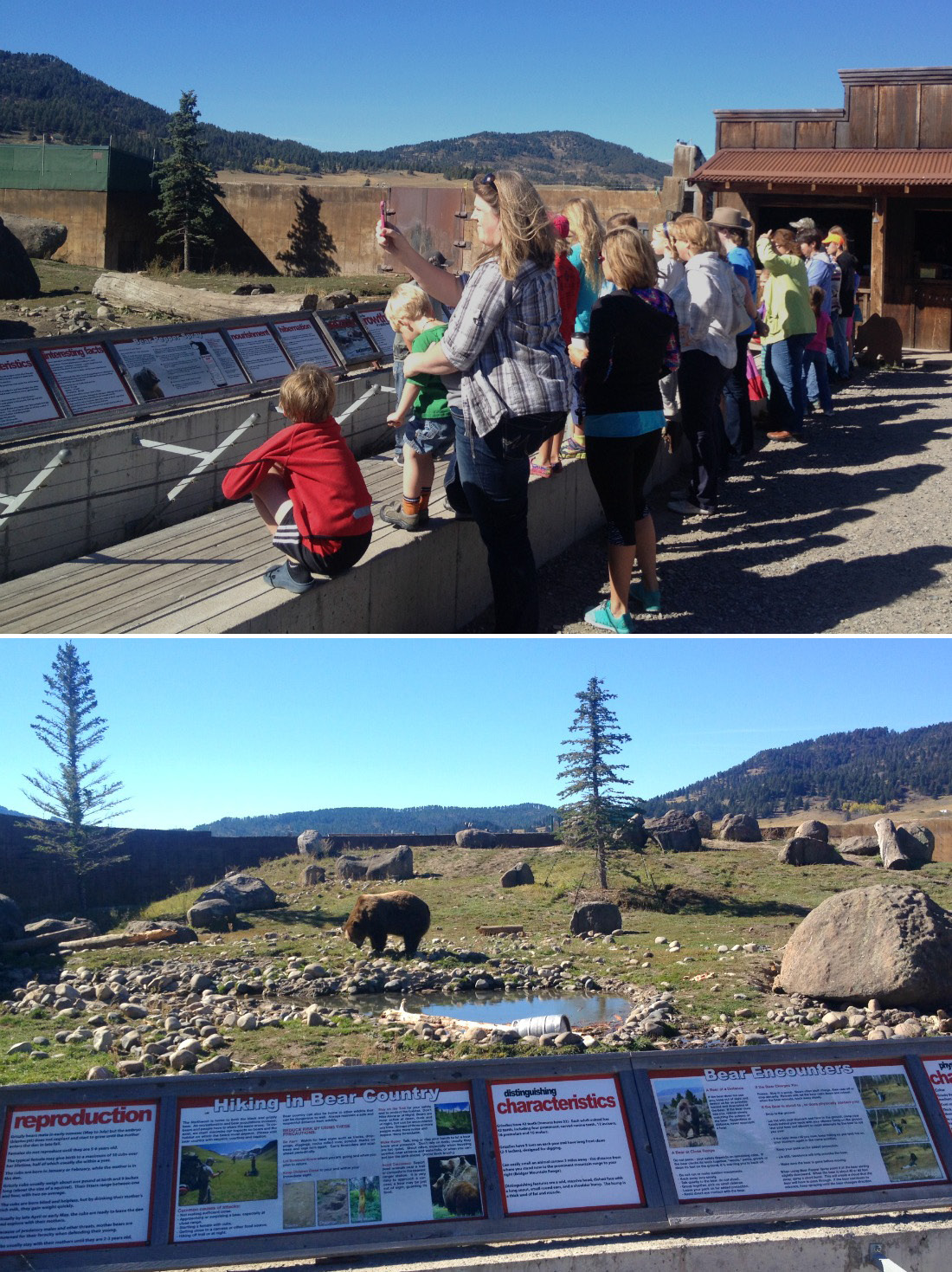Every time I drive over the pass, returning home to Livingston from Bozeman, I peer out my car window in hopes of catching a glimpse of a grizzly bear. At one time grizzlies roamed free on Bozeman Pass—and probably an occasional bear still makes her way through—but the bears I’m looking for live in a human-made habitat. They eat food that caretakers supply and frolic for gawking visitors on a daily basis.
I’ve always been tempted to pull off the highway and check out the spectacle that is Grizzly Encounter, but never quite made it until recently when I had visitors in town. I’d been torn; do I even want to see captive bears? Won’t it pale in comparison to the bears I’ve seen browsing meadows in Yellowstone or traversing a hillside in the Absarokas? Is a bear without its home still a bear? My guests provided the perfect excuse to explore behind the walls of the place I pass so often.
We drove into Grizzly Encounter, parked the car, and walked over to the bear viewing area. The large, boulder-filled hills provide a play area for five bears – who are not all outside at the same time. The bears were brought from deplorable conditions to live out the rest of their lives in comfort. A waterfall dropped from the top of the enclosure into a pond and if I looked at it just right, I could imagine the bear habitat extending into the Bridger Mountains that rose up behind it.
Like I said, I’m torn when thinking about wild animals in captive situations. The folks at Grizzly Encounter, and the other bear viewing places around Montana, use the bear experience as way to educate people about the bruins and the issues their relatives face in the wild. Zoos and other bear watching spots have come a long way from the days of tourists gawking at a growling bear being poked with a stick through the bars of a metal cage, but still, bears are meant to roam.
As I listened to the caretaker at Grizzly Encounter talk about wild bears, I remembered Gary Snyder saying, “Our place is part of what we are.” So, a bear without the wild is not really a bear, or at least it is a different bear. However, the bears we watched cannot be released into the wild. These caretakers passionately care about the bears and provide the best life possible for them. If the bruins can’t live in the wild anymore, maybe it’s worth it to use them to help us understand (and maybe protect!) their wild brethren.
In Montana there are several places to see black bears and grizzlies up close.
West Yellowstone – Grizzly and Wolf Discovery Center – 406-646-7001
Right outside the west entrance to Yellowstone National Park, the GWDC aims to provide an opportunity to learn about, view and ultimately appreciate the grizzly bear and gray wolf. An interactive museum exhibit explores the bear of myth, art, literature, history and folklore with the bear, as scientists, outdoorspeople and researchers know it. The GWDC bears are also used to test bear-resistant food storage canisters and garbage containers.
Admission (good for two consecutive days): Adults $11.50, Seniors (62+) $10.75, Children (5-12) $6.50
Bozeman Pass – Grizzly Encounter – 406-586-8893
Watch Brutus, Bella, Sheena, Jake, and Maggi play on huge boulders and in their pond and waterfall. Only a moat separates visitors from the bears. The bears help promote education for bear safety and conservation.
Admission: Adults $7.00, Seniors (65+) $6.00, Children (4-12) $5.00
Red Lodge – Yellowstone Wildlife Sanctuary – 406-446-1133
Black bears are only one of the native species housed at the Yellowstone Wildlife Sanctuary, a home for animals that cannot be returned to the wild due to injury or habituation to humans. Many of the animals Montana Fish, Wildlife & Parks confiscates (for being illegally raised) are placed here.
Admission: Adults $7.00, Seniors (55+) $6.00, Children (3- 12) $3.00
Billings – ZooMontana – 406-652-8100
Bruno was a movie star bear that didn’t get the best care before coming to the zoo. Ozzy kept getting into trouble in Yellowstone and was going to be put down if a better situation wasn’t found. Now the two play in the two-acre habitat dotted with large boulders and water features.
Admission: Adults $7.95, Seniors (55+) $5.95, Children (3-15) $4.95



